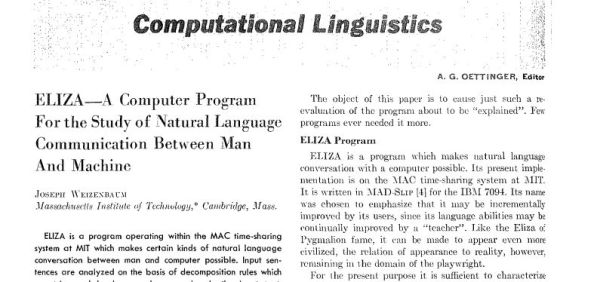Since ELIZA was created by [Joseph Weizenbaum] in the 1960s, its success had led to many variations and ports being written over the intervening decades. The goal of the ELIZA Archaeology Project by Stanford, USC, Oxford and other university teams is to explore and uncover as much of this history as possible, starting with the original 1960s code. As noted in a recent blog post by [Anthony Hay], most of the intervening ‘ELIZA’ versions seem to have been more inspired by the original rather than accurate replicas or extensions of the original. This raises the question of what the original program really looked like, a question which wasn’t answered until 2020 when the original source code was rediscovered. Continue reading “The ELIZA Archaeology Project: Uncovering The Original ELIZA”
natural language processing5 Articles
Talk To The Faucet
Your hands are filthy from working on your latest project and you need to run the water to wash them. But you don’t want to get the taps filthy too. Wouldn’t it be nice if you could just tell them to turn on hot, or cold? Or if the water’s too cold, you could tell them to make it warmer. [Vije Miller] did just that, he added servo motors to his kitchen tap and enlisted an AI to interpret his voice commands.
Look closely at the photo and you can guess that he started with a single-lever type of tap, the kind which can be worked with an elbow, so this project was probably just for fun and judging by his video below, he does have a sense of humor. But the idea is practical for dual taps with rotating knobs. He did realize, however, that in future versions he should move the servo motor openings from the top plate to the bottom instead, to avoid any water getting in. A NodeMCU ESP8266 ESP-12E board serves for communicating with the speech recognition side but other than the name, JacobAI, he’s keeping the speech part to himself. We secretly suspect that he has a friend named Jacob.
However, we can think of a number of options for it such as DeepSpeech and Wit.ai which we covered when talking about natural language phone bots, and the ubiquitous Alexa as used here with another NodeMCU for turning on Christmas tree lights.
Kathleen Booth: Assembling Early Computers While Inventing Assembly
Imagine having to program your computer by rewiring it. For a brief period of time around the mid-1940s, the first general-purpose electronic computers worked that way. Computers like ENIAC initially had no internal storage for code. Programming it involved manipulating thousands of switches and cables. The positions of those switches and cables were the program.
Kathleen Booth began working on computers just as the idea of storing the program internally was starting to permeate through the small set of people building computers. As a result, she was one of the first programmers to work on software and is credited with inventing assembly language. But she also got her hands dirty with the hardware, having built a large portion of the computers which she programmed. She also did some early work with natural language processing and neural networks. And this was all before 1962, making her truly a pioneer. This then is her tale.
Continue reading “Kathleen Booth: Assembling Early Computers While Inventing Assembly”
Echo, Meet Mycroft
The Amazon Echo is an attempt to usher in a new product category. A box that listens to you and obeys your wishes. Sort of like Siri or Google Now for your house. Kickstarter creator [Joshua Montgomery] likes the idea, but he wants to do it all Open Source with a Raspberry Pi and an Arduino.
The Kickstarter (which reached its funding goal earlier this month) claims the device will use natural language to access media, control IoT devices, and will be open both for hardware and software hacking. The Kickstarter page says that Mycroft has partnerships with Lucid and Canonical (the people behind Ubuntu). In addition, they have added stretch goals to add computer vision and Linux desktop control to Mycroft.
ScareMail Tries To Disrupt NSA Email Surveillance

Are you on the NSA’s email watchlist? Do you want to be? This project is called ScareMail and it’s designed to mess with the NSA’s email surveillance programs.
[Benjamin Grosser] has written it as a plugin for many popular web browsers, and it uses an algorithm to generate a clever but ultimately useless narrative in the signature of your email using as many probable NSA search terms as possible. The idea behind this is if enough people use it, it will overload the NSA’s search results, ultimately making their email keyword tracking useless.
So how does it work? The algorithm starts with natural language processing (NLP) and an original source of text — he picked Ray Bradbury’s Fahrenheit 451. Using the processor it identifies all nouns and verbs in the original text and replaces them with properly formatted and conjugated “scary” words that he’s indexed from a list of hypothetical NSA key words. To ensure each signature is unique, he makes use of a Markov chain to generate new texts that are completely different each time. The result is a somewhat coherent paragraph that doesn’t make any real sense.
But wait! Surveillance like this is bad, but hypothetically it could work! Well, maybe. But the point is:
ScareMail reveals one of the primary flaws of the NSA’s surveillance efforts: words do not equal intent.
Stick around after the break to see a proper video explanation of ScareMail by [Ben] himself.
Continue reading “ScareMail Tries To Disrupt NSA Email Surveillance”















